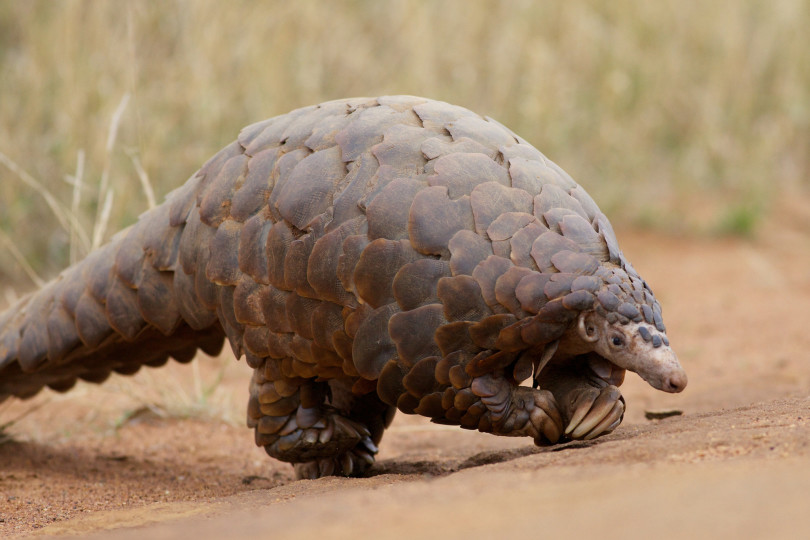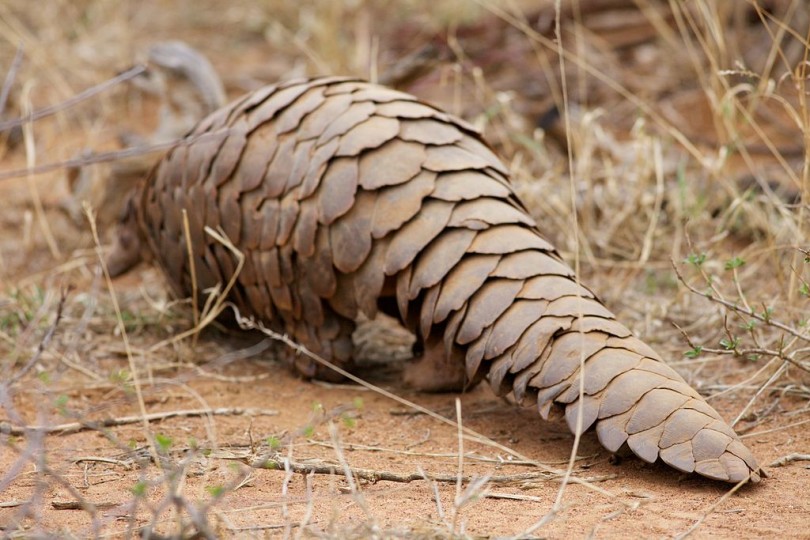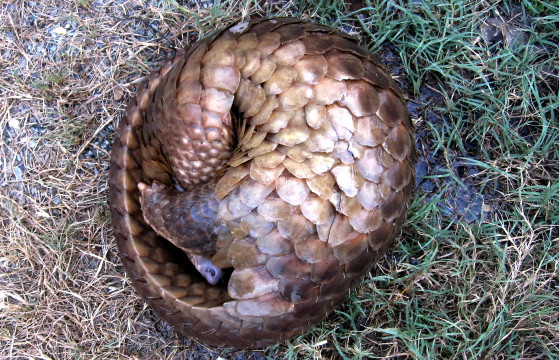Pangolins are one of the most endangered animals in the world. They are listed as critically endangered by The International Union for Conservation of Nature, which is one step away from extinct in the wild.
So just what are these scaly creatures? Learn more here:
What are pangolins?
Pangolins are nocturnal mammals that live in tropical regions in Africa and Asia. Also called the scaly anteater, these creatures are known for their suit-of-armor of overlapping scales that are made of a tough protein called keratin — the same material that makeup human nails and hair. When they feel threatened, they roll themselves into a tight ball — which is also how they got their name as word “Pengguling” is Malay for “something that rolls up”.

Pangolin scales. Photo by Leeds Museums and Galleries.
They range in size from 30-100 centimeters (12-39 inches) and their diet consists of termites and ants that they eat with extremely long tongues. According to the Save Pangolins website, their sticky tongues are attached internally near the pelvis that are ideal for capturing prey in deep cavities in the ground and on trees. When fully extended, the tongue is longer than the animal’s head and body, Save Pangolins said.
Pangolins have no teeth and they chew using spines and small stones inside their stomachs. They move by wobbling on their limbs and balancing on the outer edges of their forefeet and tucking their foreclaws underneath, Save Pangolins said.
Are they endangered?
Pangolins are considered the most illegally traded mammal in the world, according to the International Union for Conservation of Nature’s Pangolin Specialist Group. More than 1 million pangolin are believed to have been illegally taken from the wild over the past decade.
All eight pangolin species are listed on the IUCN’s Red List of Threatened Species.
Manis pentadactyla (Chinese Pangolin) – Critically Endangered
Manis javanica (Sunda or Malayan Pangolin) – Critically Endangered
Manis culionensis (Philippine Pangolin) – Endangered
Manis crassicaudata (Indian or Thick-tailed Pangolin) – Endangered
Smutsia temminckii (Cape or Temminck’s ground Pangolin) – Vulnerable
Smutsia gigantea (Giant ground Pangolin) – Vulnerable
Phataginus tricuspis (Tree or African White-bellied Pangolin) – Vulnerable
Uromanis tetradactyla (Long-tailed or Black-bellied Pangolin) – Vulnerable

Photo by David Brossard.
Why do people hunt them?
While there is a trade ban for pangolins caught in the wild in Asia, the illegal trade in pangolin continues to thrive. In the most recent case in China, the two suspects arrested said they received the shipment in international waters and were promised 10,000 yuan ($1,580) each if they delivered it to a predetermined destination.

Photo by David Brossard.
The meat is considered a delicacy in certain parts of the East and pangolin scales are used in traditional Chinese medicine. Care2 reported that a diner was spotted paying $700 for four pounds of cooked pangolin in Vietnam.
The scales are also believed to treat conditions including psoriasis and poor circulation, the IUCN reports.
What will be the fate of pangolins?
The passage of the ballot initiative in Washington state creates the most comprehensive anti-wildlife-trafficking law enacted in any state, proponents said. Violations will carry a maximum penalty of five years in prison and a $10,000 fine. Organizers hope a similar initiative can pass in the state of Oregon as well.

Ground Pangolin near Yagoi, Southern Province, Sierra Leone. Photo by Alfred Weidinger.
Authorities in China and elsewhere continue to patrol for illegal smuggling. Pangolins are listed as second-class state protected species in China.
Animal rights groups continue to raise awareness over the plight of the pangolin and hold World Pangolin Day every year on the third Saturday in February, the latest of which will fall on Feb. 17, 2018.
Comedian John Oliver is also doing his part:
 CGTN America
CGTN America
 Photo by Wildlife Alliance on Flickr.
Photo by Wildlife Alliance on Flickr.

